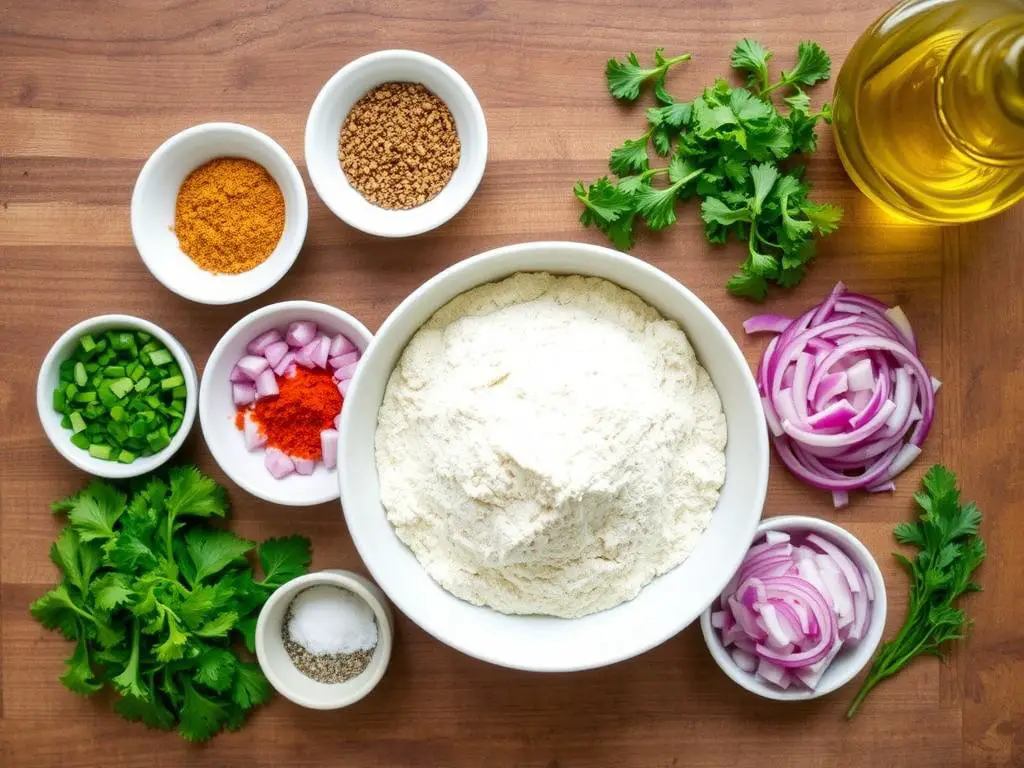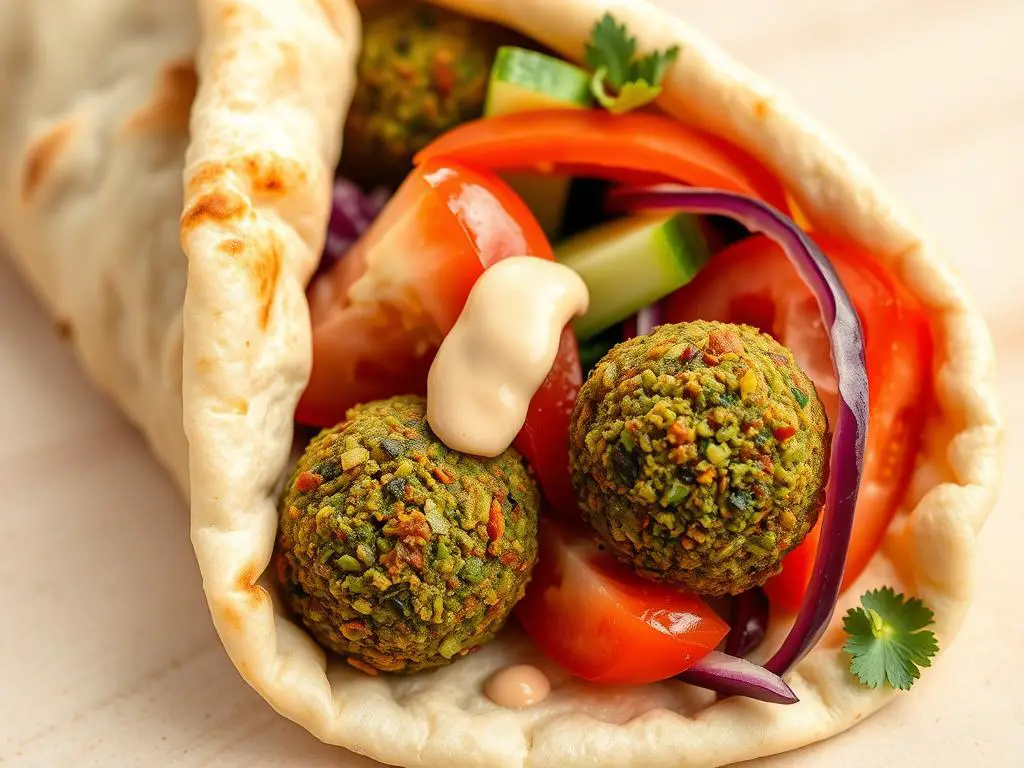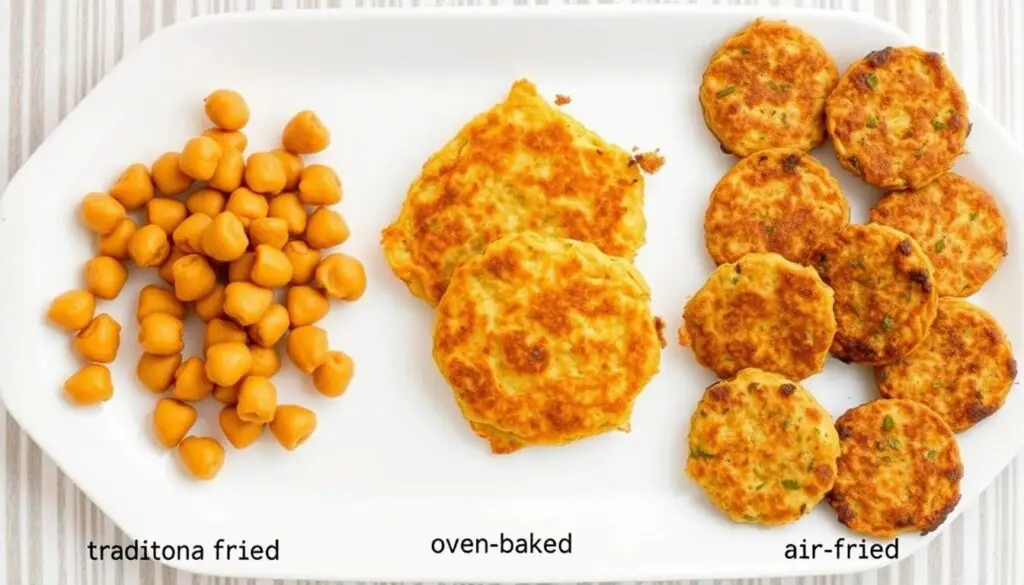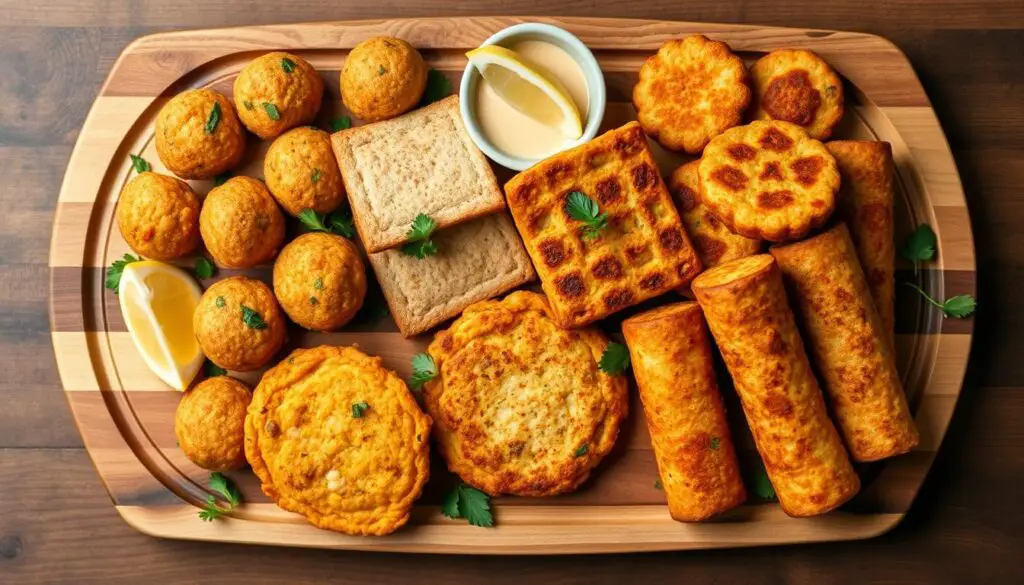From the streets of Cairo to the markets of Sicily, these golden-brown delights have been perfected across cultures for centuries.
Whether you know them as falafel, panisse, pakora, or panelle, these protein-packed fritters share a common foundation: the humble chickpea transformed into something extraordinary. Join us as we explore the world of chickpea fritters, with recipes, variations, and tips to achieve that perfect crispy exterior and tender interior every time.
Crispy chickpea fritters with fresh herbs and tangy yogurt sauce
Classic Chickpea Fritters Recipe
This foundational recipe creates perfectly crispy chickpea fritters that can be adapted to suit any taste preference. The combination of chickpea flour, aromatic spices, and fresh herbs creates a versatile base that's both vegan and gluten-free.

Fresh ingredients ready for making classic chickpea fritters
Ingredients
- 2 cups chickpea flour
- 1 small onion, finely diced
- 3 garlic cloves, minced
- ¼ cup fresh parsley, chopped
- 1 teaspoon ground cumin
- ½ teaspoon ground coriander
- ½ teaspoon baking powder
- ¾ teaspoon salt
- ¼ teaspoon black pepper
- 1¼ cups warm water
- 2 tablespoons olive oil (plus more for frying)
- Optional: ¼ teaspoon cayenne pepper for heat
Step-by-Step Instructions
- In a large bowl, combine chickpea flour, baking powder, salt, pepper, cumin, coriander, and cayenne (if using).
- Add the diced onion, minced garlic, and chopped parsley to the dry ingredients and mix well.
- Gradually pour in the warm water while stirring to prevent lumps from forming. Add the olive oil and mix until you have a smooth, thick batter.
- Cover the bowl and let the mixture rest for at least 30 minutes (or up to 2 hours) at room temperature. This allows the flour to fully hydrate and the flavors to develop.
- When ready to cook, heat about ¼ inch of oil in a heavy-bottomed skillet over medium-high heat.
- Using a tablespoon or small ice cream scoop, drop portions of batter into the hot oil, flattening slightly with the back of the spoon.
- Fry for 2-3 minutes per side until golden brown and crispy, flipping halfway through cooking.
- Transfer to a paper towel-lined plate to drain excess oil and sprinkle with a pinch of salt while still hot.

Achieving that perfect golden-brown color when frying chickpea fritters
Global Variations of Chickpea Fritters
Chickpea fritters have evolved uniquely across different cultures, each adding their own special ingredients and techniques. Here's how these delicious morsels are prepared around the world:
| Country | Name | Key Ingredients | Cooking Method |
| Middle East | Falafel | Whole soaked chickpeas, parsley, cilantro, cumin, coriander | Deep-fried in ball or patty shape |
| Italy (Sicily) | Panelle | Chickpea flour, water, parsley, lemon | Cooked paste spread thin, cooled, cut, then fried |
| India | Chickpea Pakora | Chickpea flour, onions, chilies, garam masala, turmeric | Deep-fried in irregular shapes |
| France (Provence) | Panisse | Chickpea flour, water, olive oil | Cooked polenta-like, cooled, sliced, then fried or baked |
Middle Eastern Falafel
Unlike many other variations, traditional falafel uses whole soaked chickpeas rather than flour. This creates a distinctive texture with a coarser interior and supremely crispy exterior. The generous use of fresh herbs gives falafel its signature green interior and bright flavor.

Traditional Middle Eastern falafel served in pita with fresh vegetables
Sicilian Panelle
These thin, square fritters are a beloved street food in Palermo. The batter is cooked into a polenta-like consistency, spread thin, cooled, and then cut into squares before frying. They're often served in a sandwich called “pane e panelle” with a squeeze of lemon juice.

Sicilian panelle fritters traditionally served with lemon wedges
Indian Chickpea Pakora
These spicy fritters incorporate a vibrant blend of Indian spices and often include vegetables like onions, spinach, or potatoes. The batter is looser than other variations, creating irregular, fluffy shapes with a distinctively spiced flavor profile.

Spicy Indian pakoras served with mint and tamarind chutneys
Serving Suggestions
Chickpea fritters are incredibly versatile and can be served in numerous ways. Here are some delicious pairings and serving ideas to complement their flavors:
Dipping Sauces
Tahini Sauce
Mix ⅓ cup tahini with 2 tablespoons lemon juice, 1 minced garlic clove, salt, and enough water to reach desired consistency. Perfect with Middle Eastern-style fritters.
Yogurt-Cucumber Sauce
Combine 1 cup Greek yogurt with grated cucumber, minced garlic, dill, mint, and a splash of lemon juice for a cooling complement to spicy fritters.
Herb Chutney
Blend fresh cilantro, mint, green chilies, lime juice, and a touch of sugar for a vibrant sauce that pairs beautifully with Indian-style pakoras.

Trio of complementary dipping sauces: tahini, yogurt-cucumber, and herb chutney
Serving Ideas
- In pita pockets with fresh vegetables, pickles, and sauce for a complete meal
- Atop salads as a protein-rich, crispy topping
- As an appetizer platter with various dipping sauces
- In wraps with hummus and roasted vegetables
- As a side dish alongside grilled vegetables or grain bowls
- In sandwiches like the Sicilian “pane e panelle”
Tips for Success
Creating perfect chickpea fritters can be simple once you understand a few key techniques. Here are expert tips to ensure your fritters turn out crispy, flavorful, and perfectly cooked every time:
Pro Tips for Perfect Texture
- Rest the batter for at least 30 minutes to allow the flour to fully hydrate
- Maintain proper oil temperature (350-375°F/175-190°C) for optimal crispiness
- Don't overcrowd the pan as this lowers oil temperature and creates soggy fritters
- Pat dry any watery vegetables before adding to prevent excess moisture
- Use a heavy-bottomed pan for even heat distribution
- Drain on paper towels immediately after frying
- Salt while hot for better flavor absorption
Troubleshooting Common Issues
Soggy Fritters
If your fritters aren't crispy, the oil temperature may be too low. Use a thermometer to maintain 350-375°F. Also, ensure your batter isn't too wet – it should be thick enough to hold its shape when dropped into oil.
Fritters Breaking Apart
This usually happens when the batter is too loose. Add a bit more chickpea flour, one tablespoon at a time, until the mixture holds together. Also, handle them gently when flipping.
Bland Flavor
Don't be shy with seasonings! Chickpea flour can absorb a lot of flavor. Add more herbs, spices, and don't forget adequate salt. Remember to taste the batter (before adding raw ingredients if using) and adjust seasonings.
Burning Outside, Raw Inside
Your oil is likely too hot. Lower the heat and make the fritters a bit smaller or flatter to ensure they cook through before the outside burns.
Dietary Adaptations
One of the best things about chickpea fritters is that they're naturally suited to many dietary needs:
- Gluten-Free: Chickpea flour is naturally gluten-free, making these fritters perfect for those with celiac disease or gluten sensitivity.
- Vegan: The basic recipe contains no animal products. Just ensure your cooking oil is plant-based.
- Low-Oil Version: For a lighter option, bake the fritters at 400°F (200°C) for about 15 minutes per side, or use an air fryer at 375°F (190°C) for 12-15 minutes, flipping halfway through.

Comparison of cooking methods: deep-fried (left), oven-baked (middle), and air-fried (right)
Cultural Context: The Origins of Falafel
While chickpea fritters appear in many cuisines, perhaps none is more globally recognized than falafel. Though its exact origins are debated, most food historians trace falafel back to Egypt, where it was likely created by Coptic Christians as a meat substitute during Lent.

Traditional falafel vendor at a Cairo street market
Originally made with fava beans (and still prepared this way in Egypt today), falafel spread throughout the Middle East where chickpeas became the preferred ingredient in many regions. The dish gained international popularity in the mid-20th century as Middle Eastern immigrants brought their culinary traditions to new shores.
Today, falafel stands as a powerful example of food as cultural ambassador – a humble street food that crossed borders to become a globally beloved dish. In many Middle Eastern countries, falafel shops are community gathering places where people from all walks of life come together over this simple, satisfying food.
“Falafel is the great equalizer – from workers to businesspeople to students, everyone stands in the same line for this perfect handheld meal.”
Embrace the Versatility of Chickpea Fritters
From their humble origins to global popularity, chickpea fritters demonstrate how a simple combination of ingredients can evolve into countless delicious variations across cultures. Whether you prefer the herb-packed falafel of the Middle East, the delicate panelle of Sicily, or the spice-infused pakoras of India, these protein-rich fritters offer endless possibilities for culinary exploration.
The beauty of chickpea fritters lies in their adaptability – they welcome experimentation with different herbs, spices, and cooking methods. They can be an appetizer, side dish, or main course. They're economical, nutritious, and satisfy both everyday cravings and special occasions.
Share Your Chickpea Fritter Adventure!
Have you created your own unique variation of chickpea fritters? Or do you have a family recipe passed down through generations? We'd love to hear about your favorite way to prepare this versatile dish!

A celebration of global chickpea fritter variations – from falafel to panelle to pakora


